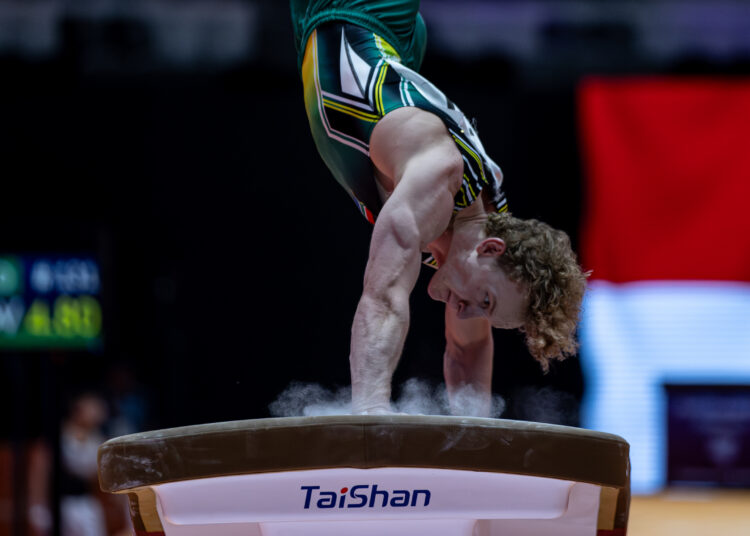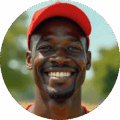At the 2025 FIG Artistic Gymnastics World Championships in Jakarta, the narrative of Luke James injury and representation became a study in resolve, as the 23 year old South African competed through pain to wear his country’s colors on the world stage. With a dislocated finger suffered in the final days before competition, he narrowed his program to the floor and the vault, then stepped up in qualification with composure that spoke louder than any medal count.
James is among the very few South African male gymnasts to appear at this global event, a distinction that captures both his personal ascent and the growing ambitions within the nation’s gymnastics community. A Capetonian now training in the United States on scholarship at the University of Nebraska, he has built a reputation in the collegiate arena for standout performances, and brought that competitive edge to Indonesia despite the setback that arrived at the worst possible time.
The moment adversity struck
In the final phase of pre event training, James dislocated a finger while attempting a demanding Suarez skill on the parallel bars, a high risk element that has now twice tested his durability. He detailed how the accident shook the plan for an all around outing, and how he processed the blow in real time, weighing what was still possible against what the injury would allow.
The dislocation happened on a Suarez skill on parallel bars. This is the second time I have dislocated a finger on this skill, which is upsetting, but as the skills get harder, that is just the nature of the sport. The first thought that ran through my mind was, why is this happening now. My first concern was whether I could compete on all six events with the hurt finger, so immediately I just went into, okay, let us get this thing healed and see if I can compete the all around.
After several days of assessment, the call was made to scale back. James and his team chose to preserve what strength and stability remained by targeting the events that demanded less of the injured hand, the floor and the vault, a strategic pivot that gave him a path to compete while limiting unnecessary risk.
After a tough couple of days evaluating the finger and seeing if it would get better and ready for all around, we decided to make the tough call to just drop to two events. Luckily, my strongest events are the ones that do not require me to use my finger, so that was the plus side to it. But it was definitely a mental blow. I knew that if I stayed mentally sharp and focused, I could still do well in those two events.
Day one in Jakarta and the power of composure
On day one of men’s qualifications, at Indonesia Arena on 19 October 2025, James delivered the kind of presence that earns respect in any arena. He posted 11.9 on the floor, with the breakdown listed as 6.6 and 5.4, and he secured 13.25 on the vault from a two vault total, with figures of 13.9 and 12.6. The numbers do not fully capture the context, an athlete recalibrating on the fly and finding a way to compete for South Africa when it would have been easier to step aside.
The scores did not match his ambition, and James did not hide that disappointment. Yet the outlook he voiced in Jakarta showed why he continues to advance as a performer. He allowed himself a brief window to feel the sting, then moved to the questions that fuel growth, how to turn the setback into better days ahead, how to refine his craft under pressure.
I am a little disappointed in how I performed. However, there is so much to learn in failure, and I try to approach it with the mindset of how can I use this to improve instead of dwelling. I gave myself 24 hours to be upset and disappointed, and then I flipped the script, how can I use this to be a better gymnast, a better person, a better competitor, a better teammate.
A dream built in Cape Town and tested in Jakarta
Long before the bright lights in Jakarta, the World Championships stage lived in James’s imagination back home in Cape Town. He speaks about this meet as a dream that took root when he was around 10 years old, shaped by the example of seniors at his club. Among those names was Siphesihle Biyase, a figure who competed at the 2014 Commonwealth Games in Glasgow and left a lasting imprint on a young gymnast who watched and dared to aim higher.
Competing at the World Championships for South Africa has been a dream of mine since I was a young boy, maybe from the age of ten. I grew up watching guys from my club like Siphesihle Biyase, they were my heroes. They competed at the 2014 World Commonwealth Games in Glasgow, and that really inspired me. So yeah, it is been a lifelong dream.
Simply taking the floor in Jakarta fulfilled a promise to that younger self, an experience that James says he will never take for granted. He emphasized the privilege of wearing the South African flag, and he framed the performance, imperfect as it felt, as part of a larger journey that continues to unfold with each routine.
It was definitely not the result I hoped for, but just getting to compete amongst my peers and some of the best in the world was an experience I will never take for granted. Getting to wear the South African flag on my chest is always an honour, and I could not be more grateful.
A champion’s pedigree from Africa to the world
James arrived in Indonesia as the reigning African floor and vault champion, achievements earned in Marrakech, Morocco last year. That continental double speaks to his talent profile, dynamic on the floor and explosive on the vault, and it offers context for why his decision to focus on those two events was more than a concession to injury. It aligned with where he has already proven himself among the best on the continent.
His trajectory also mirrors South African gymnastics reaching for greater visibility on the global stage. Representation matters, and James’s presence among the select group of South African men who have competed at Worlds sends a signal to the next generation. For young athletes in Cape Town clubs, the sight of a compatriot standing tall in Jakarta reinforces that the path is real, and that setbacks, even a finger dislocation, are a chapter rather than the ending.
What he learned and what comes next
There is a maturity to the way James speaks about preparation, recovery, and accountability. He reflected on training choices in the lead up to Worlds, admitting that he may have pushed too hard, a familiar pitfall for athletes who anchor their confidence in relentless work. The lesson, as he frames it, is to listen closely to the body, to build smarter, and to arrive healthy when the big stage beckons.
I think a big mistake that I made was maybe over preparing. I really beat my body down in the preparation for this competition, and it has been a real struggle to stay healthy. But I am grateful to my coaches and athletic trainer back in the US for keeping me going.
He is clear eyed about the role of luck and chance in sport too. A misstep on a demanding element is sometimes just that, an accident, and the productive way forward is to adjust, to rebuild confidence, and to lean on the support networks that sustain elite athletes across seasons and continents.
With the finger, that is something that is kind of out of my control. Mistakes and accidents happen in sport, and I will learn from them. It was not the performance I wanted, but these things happen, and I will be better off because of it.
Jakarta memories and the warmth of a host city
There is more to a world championship than scores on a results sheet. James spoke with appreciation about the competition environment in Indonesia, praising the arena, the spectacle, and the people who made the experience memorable. He noted that the equipment felt different from what he uses in the United States, which required a quick period of adaptation during the training days.
The arena was just stunning. The colour scheme was so cool, it felt like a dream being there, at this massive event with TV crews and cameras everywhere. The equipment was quite hard for me to get used to, definitely different from what I am used to in the States, but I just did my best over the week to adjust and get ready to compete. It was awesome.
What lingered just as strongly was the welcome he felt. He described the Indonesian culture as beautiful, the people as polite and hospitable, and the overall vibe as warm and inviting from the minute he arrived. For an athlete traveling far from home, those human touches matter, and they add to the motivation to return stronger.
One of the biggest privileges and benefits of competing at the highest level is getting to travel the world and experience different cultures. The Indonesian culture is just beautiful, the people are so polite and hospitable, and it really did feel warm and welcoming from the minute I walked in. It was such a lovely experience competing out here.
Carrying the South African flag with pride
James was the lone male gymnast in a South African contingent of five at these World Championships, a group that also included Olympians Caitlin Rooskrantz and Naveen Daries, along with Zelme Daries and Buthle Nhleko, who made their World Championships debuts. The presence of this squad signaled both continuity and renewal, veterans alongside newcomers, all united by a common goal to elevate South African gymnastics on a high profile stage.
That context adds weight to what James did in Jakarta. He showed up in the face of adversity and competed, a reminder that representation is not only about podiums. It is about visibility, about courage, about the message that ripple effects can be sparked by an athlete who chooses to stay in the arena when the circumstances shift unexpectedly.
The chapter that points forward
James’s own words frame this meet not as a destination, but as a catalyst. He knows there is more in his gymnastics, that healthier months of training will allow him to attack all six events again, that the skills on parallel bars and beyond can be refined with patience and care. The commitment, as he expressed it, is to return stronger, smarter, and better prepared.
It was not the result I hoped for, but representing South Africa on this stage means everything. And I will be back, stronger, smarter, and better for it.
In the end, the story that emerged in Jakarta was not defined by a number on a scoreboard. It was defined by a choice. Faced with an injury that could have ended his campaign, Luke James adapted, competed, and upheld the standard he set for himself years ago. For South African gymnastics, for teammates and young dreamers watching from home, and for anyone who believes in the long road of craft and character, that is a result worth remembering.
Jakarta will be a reference point for James, a week that tested him in body and mind, and a reminder of what it means to be a competitor. The finger will heal, the training will recalibrate, and the next routines will carry the lessons forward. The image of a South African gymnast taking to the floor and the vault in qualification, despite the sting of a recent dislocation, will remain, a marker of grit in a demanding sport.
As the lights dim on this edition of the FIG Artistic Gymnastics World Championships, the takeaway is clear. The journey continues, and Luke James has already shown he is ready to write the next pages with the same poise he brought to Jakarta, one routine at a time.






